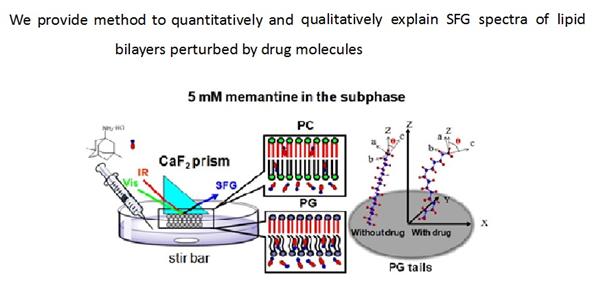Qualitative and Quantitative Analyses of the Molecular-Level Interaction between Memantine and Model Cell Membranes
writer:Bolin Li, Hong-Yin Wang, Peiyong Feng, Xiaofeng Han, Zhan Chen, Xiaolin Lu*, and Fu-Gen Wu*
keywords:SFG, lipid bilayer, interfaces
source:期刊
specific source:JPCC
Issue time:2015年

Sum frequency generation (SFG) vibrational spectroscopy was employed to study the interaction between
memantine (a water-soluble drug for treating Alzheimer’s disease) and lipid bilayers (including zwitterionic PC and
negatively charged PG lipid bilayers) at the molecular level in real time and in situ. SFG results revealed how the memantine affected these lipid bilayers in terms of the lipid dynamics, average tilt angle (θ), as well as angle distribution width (σ). It was found that memantine could adsorb onto the zwitterionic PC surface but did not affect the flip-flop rate of the PC bilayer even in the presence of 5.0 mM memantine, indicating the negligible interaction between memantine and the PC bilayer. However, for the negatively charged PG bilayer, it was found that the outer PG leaflet could be significantly destroyed by memantine at a relatively low memantine concentration (1.0 mM), while the inner PG leaflet remained intact. Besides, the θ and σ of CD3 groups in the outer PG lipid leaflet were calculated to be ~82.0° and ~19.5° after adding 5 mM memantine, respectively, indicating that these CD3 groups were prone to lie down at the membrane surface (versus the surface normal) with the addition of 5 mM memantine while nearly standing up without the addition of drug molecules. These monolayer- and molecular-level results could hardly be obtained by other techniques. To the best of our knowledge, this is the first experimental attempt to quantify the drug-induced orientational changes of lipid molecules within a lipid bilayer. The present work provided an in-depth understanding on the interaction between memantine and model cell membranes, which will potentially benefit the development of new drugs for neurodegenerative diseases involving drug?membrane interaction.
http://pubs.acs.org/doi/abs/10.1021/acs.jpcc.5b05747